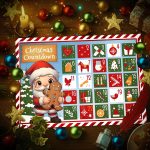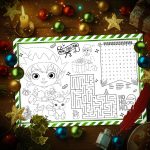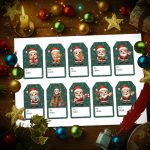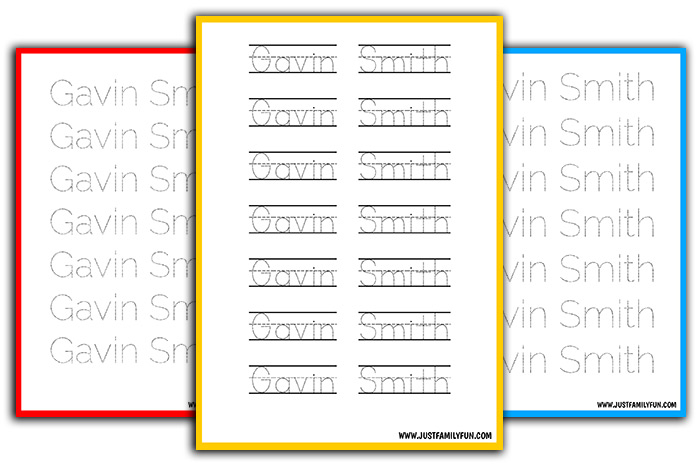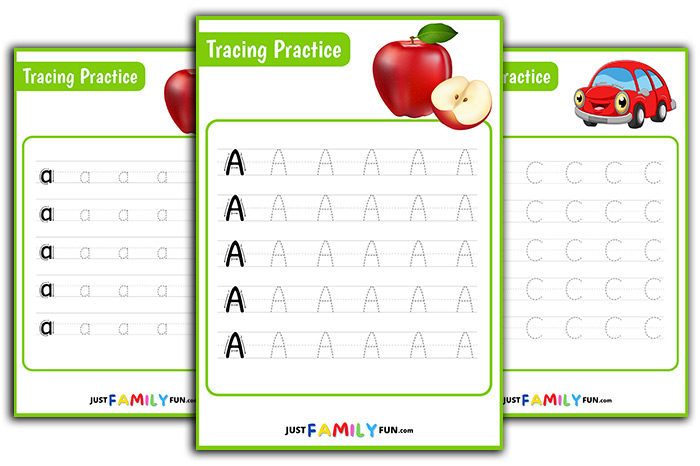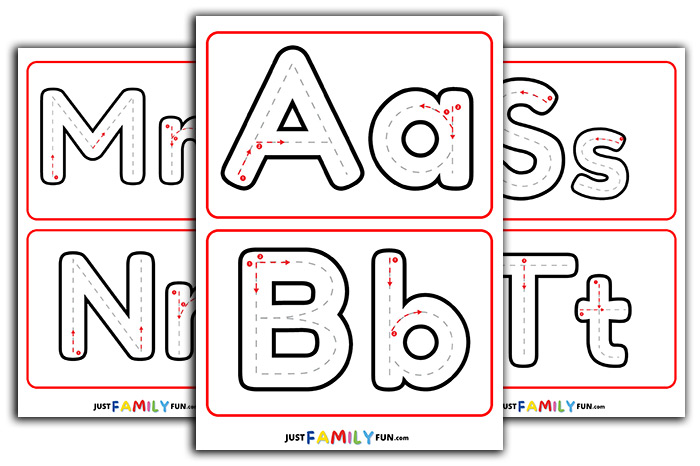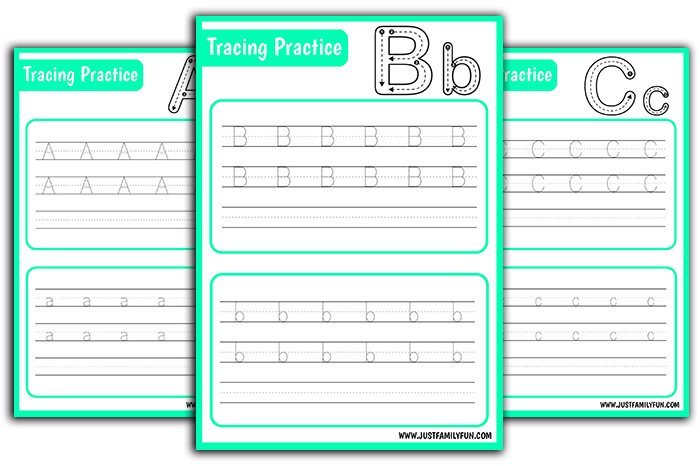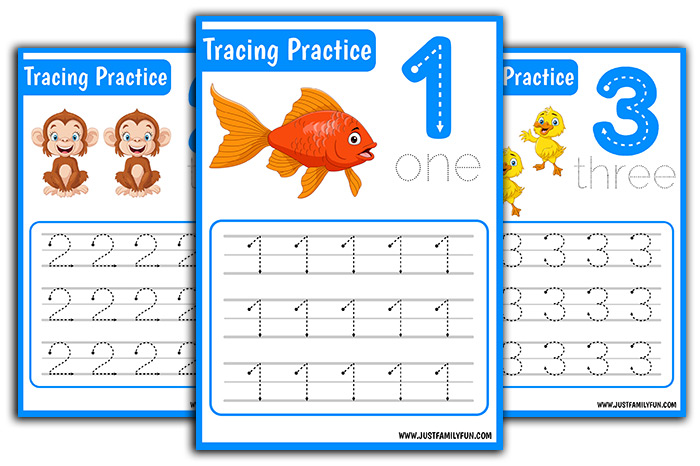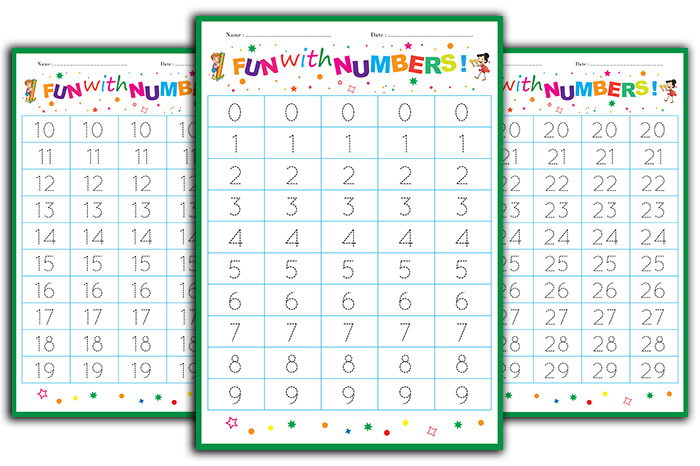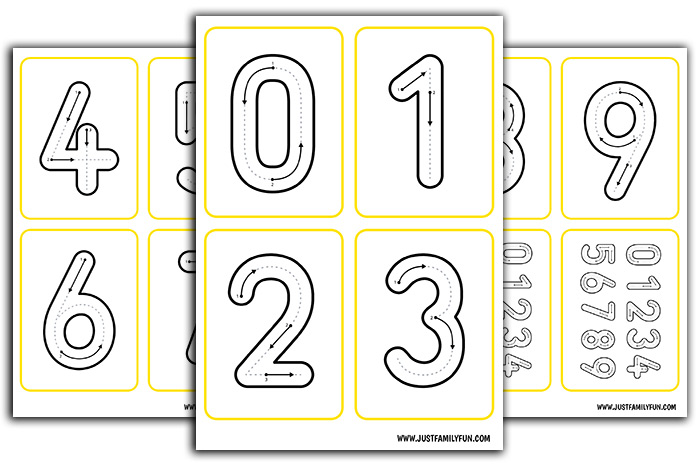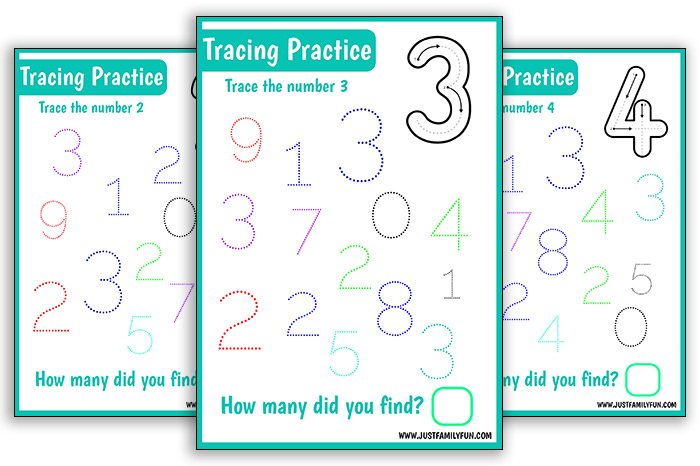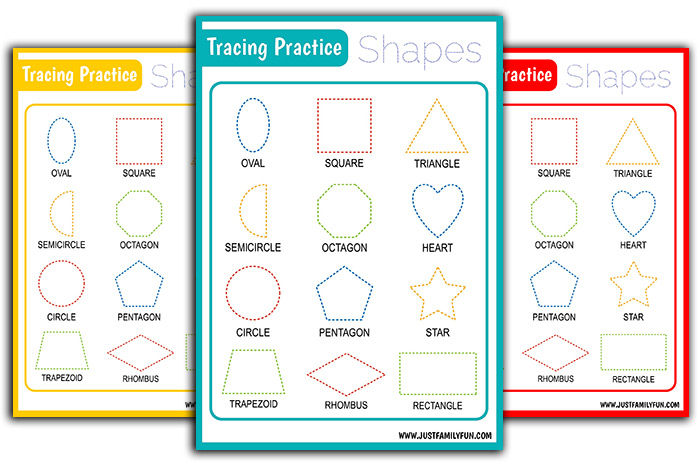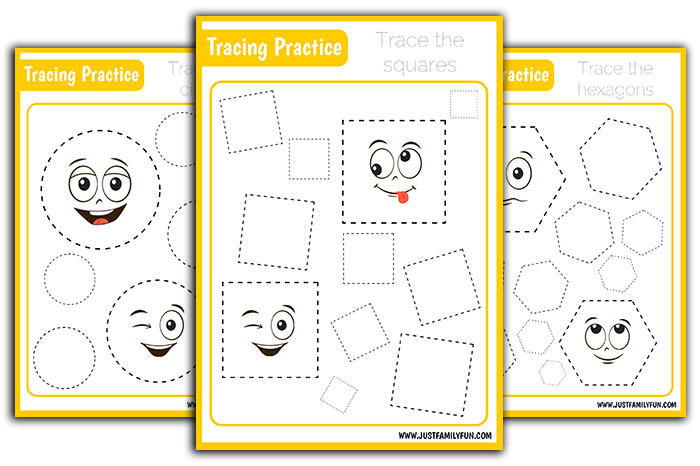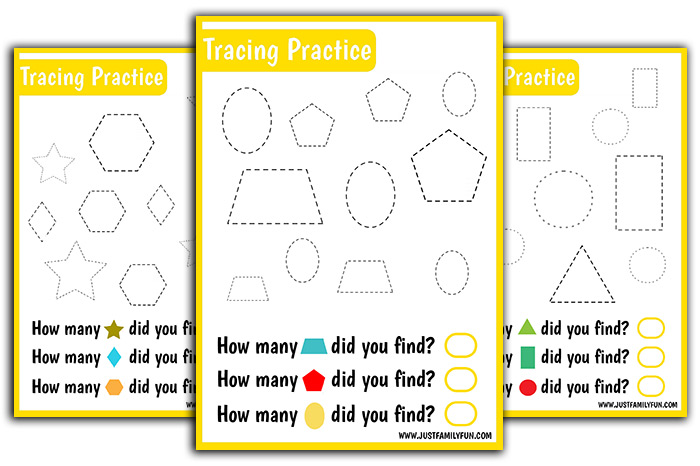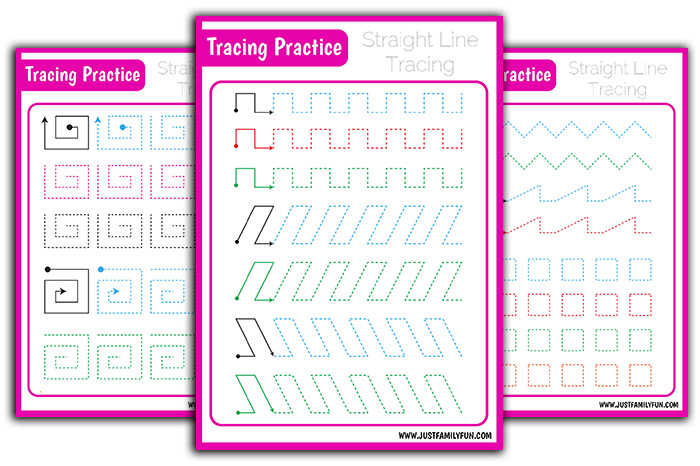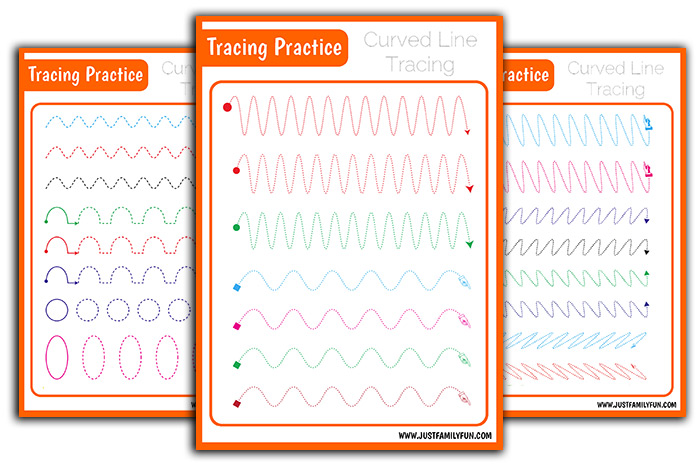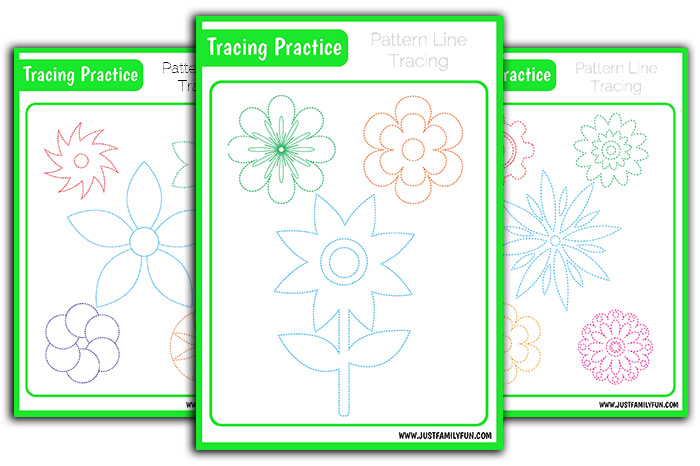Alphabet Letter Tracing & Shapes Worksheets
Table of Contents
Are you looking for a fun and interactive way to help your preschool or kindergarten-aged child develop their writing skills? Look no further than our alphabet letter tracing & shape worksheet for preschool! This simple yet effective tool can make learning to write more engaging and enjoyable for young children.
In this post, we’ll explore the benefits of using tracing worksheet, provide tips on how to use them effectively and share free Shape Tracing Worksheets, Letter Tracing Worksheet and Number Tracing Worksheet that you can use with your child at home or in the classroom. Get ready to see your child’s writing skills improve before your eyes!
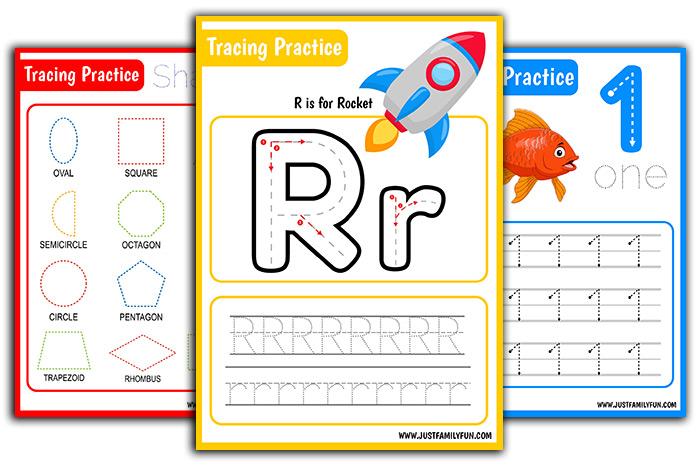
Benefits of using tracing sheets
Using printable tracing worksheets can offer many benefits for young children who are learning how to write and develop their fine motor skills. Here are some of the benefits:
- Develops Hand-Eye Coordination: Tracing worksheets require children to follow a specific path, which can help improve hand-eye coordination as they learn to control their movements.
- Improves Fine Motor Skills: Tracing worksheet requires children to use small muscles in their hands and fingers, which helps them develop fine motor skills that are necessary for writing and other activities.
- Enhances Letter, Shape and Number Recognition: By tracing letters, children can become more familiar with letter shapes and how they are formed, which can help with letter recognition and reading readiness.
- Builds Confidence: As children master tracing skills, they can gain confidence in their abilities and feel more motivated to continue learning. Tracing an image can help you focus on the physical demands of drawing without worrying about whether you’re getting it right.
- Fun and Engaging: Tracing worksheets can be fun and engaging for children, especially when they feature colourful images or incorporate games and puzzles. This can make the learning process more enjoyable and effective.
- Improves Spacial Awareness: Spatial awareness is the ability to understand and interact with the environment, objects, and shapes in relation to oneself. This skill is essential for various daily activities and cognitive tasks.
- Sets the foundation for writing, reading and math: writing letters, numbers and shapes are essential skills when learning to read, write and do maths, science, technology and other sports.
- Pencil control and precision: As children trace shapes, letters, and numbers, they learn to control their pencil movements more accurately, allowing them to navigate through space with greater precision.
- Directionality: Tracing activities help children understand concepts like left, right, up, and down, as well as the orientation of shapes and letters.
- Understanding shapes and proportions: Tracing different shapes, letters, and numbers helps children recognize and comprehend their unique properties, such as size, angles, and symmetry.
Overall, using printable tracing worksheets can be a useful tool for parents and educators to support young children’s handwriting and fine motor skill development in a fun and engaging way.
Can Tracing Activities Enhance Learner’s Readiness For Reading?
Yes, tracing activities can enhance learners’ readiness for reading. Tracing activities can help children with letter recognition, which is a key component of learning to read. When children trace letters, they become familiar with letter shapes and how they are formed, which helps them recognize letters more quickly and easily.
In addition, tracing activities can help children develop hand-eye coordination and fine motor skills, which are important for tasks like holding a pencil or turning pages in a book. These skills are also essential for learning to write, which is closely tied to learning to read.
Tracing activities can also help children develop concentration and focus, as they need to maintain their attention on the task at hand in order to trace accurately. This can be an important skill for reading comprehension, as well as for other academic tasks.
Overall, while tracing activities may seem simple, they can have a significant impact on young learners’ readiness for reading and academic success.
What's Included On This Page
As you scroll down the page you will find worksheets to help you assist your child learn letters, numbers and shapes. Each section contains multiple different sheets so you can start with basic skills and swap the sheets for the next set as your child progresses.
How To Use The Tracing Worksheets
Once you have found the tracing sheets suitable for your child’s level, simply click on the button, download the free printable pdf and hit print on your computer.
Once you have printed your selected sheet out, learners can trace over the large, clear letters with a pencil, crayon, felt tip or marker.
At first, your child might struggle to stay on the dotted lines, but the more they practice, the better your child will get at making perfectly formed letters, numbers and shapes.
Making The Sheets Reusable
Whilst you can print our free tracing worksheets out as many times as you wish, you can also laminate the sheets making them winnable, reusable tracing worksheets. If you plan to laminate your sheets you can print them out onto thick paper or cardstock.
Letter Tracing Worksheets
Letter tracing worksheets are educational tools designed to help young children learn how to write letters of the alphabet.
As well as developing their fine motor skills and hand-eye coordination as mentioned above, it helps them recognise letter shapes. By practising tracing and writing letters, children can build a strong foundation for literacy skills such as reading and writing.
Below you will find a selection of different letter tracing worksheets that allow you to support children’s handwriting development in a fun and engaging way.
Choose between our tracing sheets featuring the alphabet, letters, and flashcards and there is even a name generator to help children learn how to spell and recognise their names.

Name Tracing Worksheets Generator
To print out a tracing sheet with your child’s name on it, simply click on the button labelled “Download Name Generator PDF Files” and this will open a pdf file where you can enter the child’s name, choose from one of three templates (blue, red, white and yellow) then Download and print the PDF.
Let your child trace over their name, building their confidence in how to spell and write their name. Feel free to print it as many times as you like, using their first name to start with and then maybe their full name or just their initials.
Tracing Alphabets Worksheets
The Printable tracing alphabets worksheets are an excellent resource for helping children practice writing all 26 letters of the alphabet in both capital and lowercase forms. These worksheets encourage the development of fine motor skills, hand-eye coordination, and letter recognition.
The PDF features three sheets in different colours: red, yellow, and blue, allowing you to select the colour your child prefers. Apart from the colour, the three sheets included in this download are identical.
Encourage your child to trace over each letter, both capital and lowercase, following the lines provided on the worksheet. Repeat the activity as needed to help your child become more comfortable and confident in writing the entire alphabet.
26 ABC Tracing Printable Worksheets
The ABC Tracing Printable Worksheets are specifically designed to help children and beginners learn and practice writing individual letters of the alphabet. These worksheets provide a step-by-step approach to letter formation and are perfect for focusing on one letter at a time.
Each worksheet highlights a single letter of the alphabet, both in capital and lowercase forms. The top half of the page displays a large outline of the featured letter, complete with arrows indicating the correct stroke order and direction for proper letter formation. A related image that starts with the featured letter is included to reinforce letter recognition and phonetics.
The lower half of the sheet contains two lines of the featured letter in a smaller size, with one row for capital letters and another for lowercase letters.
To use the ABC Tracing Printable Worksheets:
- Download and print the desired worksheet featuring the letter you want your child to practice.
- Have your child trace the large letter at the top of the page, following the arrows to ensure proper stroke order and direction.
- Encourage your child to study the related image and discuss its connection to the featured letter, reinforcing letter recognition and phonetics.
- Ask your child to trace the smaller letters in the bottom half of the sheet, focusing on maintaining consistent size and shape.
- Repeat this process for each letter of the alphabet as needed.
52 Letter Tracing Sheets
The Letter Tracing Sheets are an excellent resource for helping learners practice writing individual letters of the alphabet. With each sheet focusing on one letter, either in uppercase or lowercase form, these worksheets offer a more focused approach to learning letter formation and handwriting techniques. By focusing on one letter at a time, learners can systematically and gradually develop their handwriting skills, building a strong foundation for future reading and writing success.
Each sheet highlights one letter of the alphabet, either in uppercase or lowercase form. The worksheet provides 30 outlines of the target letter, giving your child plenty of opportunities to practice writing the individual letter.
These sheets are perfect for use after your child has mastered the ABC tracing sheets mentioned earlier, as they allow for more concentrated practice on one letter at a time.
Focus on one letter of the alphabet at a time. Encourage your child to trace each of the 30 outlines of the target letter, focusing on maintaining consistent size, shape, and proper stroke order. Once your child is comfortable with the current letter, move on to the next letter in the alphabet. Continue this process until your child has practised and mastered each letter of the alphabet.
Tracing Alphabets Flashcards
These alphabet flashcards are perfect for those children just beginning to learn the letters of the alphabet.
Each letter of the alphabet is written in large, A5-sized bubble writing in lower and upper case with a dotted line inside the bubble outline for learners to practice tracing the bubbly letters. Learners become familiar with the shape while enjoying the playful design.
You could print the flashcards onto a durable material like thick paper or cardstock and laminate them, making them easy to handle, wipe clean, and reuse multiple times.
How To Help Your Child Learn the Letters With These Flashcards
To help your child learn the letters ask your child to trace around the line of the letter, lower and upper case. You can then, show your child the letter on the card and demonstrate the sound that letter makes.
Ask your child to point to the letter and repeat the sound. Separate cards into piles of “I know” and “I don’t know.” Practice daily with the “I don’t know” cards while reviewing the “I know” pile. This builds confidence for your child and helps with their active recall.
Other ways to Use the flashcards
Colouring letters: Allow children to colour inside the letters or decorate them with patterns. This activity can reinforce letter recognition while stimulating their creativity and artistic expression.
Letter matching games: Play a letter-matching game using our bubble letter flashcards. Once your child has traced several of the letters or coloured them in – cut the cards in half, so you have the uppercase on one half and the lowercase bubble letter on the other side. Ask learners to match the corresponding uppercase and lowercase letters, reinforcing their understanding of the alphabet.
Learn to spell basic words: Using the individual letters made in the letter-matching game, make small three-letter words like cat, bat, rat, dog and jet and help your child learn to read basic words.
Alphabet Tracing Worksheets PDF
These alphabet letter tracing sheets have one letter per page, featuring the uppercase letter form in the top half and the lowercase form in the lower half. They are designed to help children and beginners learn and practice writing both uppercase and lowercase versions of individual letters.
Similar to the 52 letter tracing sheets above these alphabet tracing worksheets allow your children to focus on a single letter mastering its correct formation and handwriting technique in both cases. By providing both uppercase and lowercase letter forms on the same page, learners can easily compare and understand the differences and similarities between the two cases. These sheets are perfect to use after the ABC tracing printable sheets and the 52-letter tracing sheets.
Free Handwriting Lined Paper
Once your child has learned to write letters, they will love to practice writing letters, words and sentences. Handwriting Lined paper is the perfect resource for them to use when practising their newly acquired writing skills as it features specially spaced lines to guide children in their handwriting practice. These lines help children learn to write neatly and consistently and provide a structure for them to follow as they develop their handwriting skills.
Using handwriting-lined paper can offer several benefits for young learners, including:
- Improved Handwriting: The consistent spacing of the lines on handwriting paper can help children form letters more accurately and consistently, leading to improved handwriting overall.
- Enhanced Letter Formation: The lines on handwriting paper can also help children learn how to form letters correctly and proportionally, which is an important skill for legibility and readability.
- Better Spacing and Alignment: Handwriting paper can help teach children how to space their letters and words evenly, and how to align their writing on the page.
- Increased Confidence: As children improve their handwriting skills and see their progress on paper, they may feel more confident in their abilities and more motivated to continue practising.
Why not download and print this free handwriting-lined paper for them to use? Print it out as often as you like.
This free handwriting-lined paper is a little more exciting than most as it’s available to download and print in a variety of colours
Number Tracing Worksheets
Number tracing worksheets are superb for helping children and beginners learn and practice writing numerals, ranging from 0 to 9 and beyond. These worksheets aim to enhance number recognition, develop fine motor skills, as well as improving handwriting technique.
We’ve designed a series of number tracing sheets that help children learn and write numbers. Whether your child is just learning to recognise numbers or learning to write numbers as big as 1109 we have you covered.
Start with our large flashcards, featuring a single numeral and work your way through the sheets until your children can write numbers in the thousands.
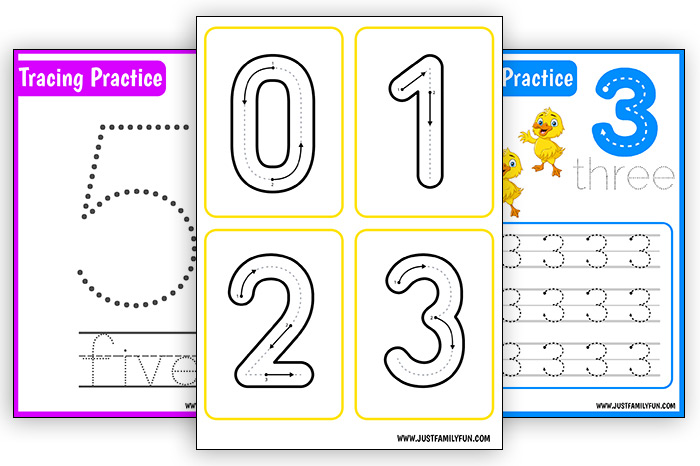
All of the number tracing worksheets are a great activity to use to help children trace the numbers 0-10 and beyond, reinforcing their number formation skills. Building confidence with number recognition is essential when moving on to foundation mathematical concepts. Learning numbers is the first step in building a strong maths foundation required for math skills like counting, addition, and subtraction.
Printble Number Trace Worksheets Numbers 1-9
These printable number trace worksheets for numbers 1-9 are perfect to help young children learn and practice writing numbers from one to nine. These worksheets feature large, clear numerals for tracing, dotted lines or arrows to guide children in forming each number correctly.
In the corner of each sheet, there is an image to represent the numeral being traced. For example, the printable number trace worksheet for the number 1 includes an image of one fish and the number 4 worksheet features four zebra. This visual representation can help children make connections between the numeral and its quantity, and can also add an element of fun to the learning process.
There is also an extra large numeral and the numeral is written in letters. These are also traceable.
Dotted Number Worksheets ( Number 1- 1109 )
Challenge your children to write numbers from 1 up to 1109 with these dotted number worksheets for numbers 1-1109.
Each sheet features a grid with 9 different numbers to practice, each number is repeated 5 times on a line. The sheets are bright and jazzy to entice children to complete the sheets. There is space for children to write their names and the date at the top.
This downloadable PDF has 111 pages! It’s an amazing resource for those learning to write larger numbers.
Help Your Child Read and Write Larger Numbers
Games are a great way to help children learn larger numbers. Here are a few ideas of how you can use this worksheet.
Find or Say The Number
You could turn this into a game after you have practised writing all the numbers. Simply lay the sheets out, pick a number and say it out loud – see how quickly they can locate the number you said. Or point to a number and challenge them to read the number and tell you what it is.
Practice Addition and Subtraction
You could expand upon these sheets by introducing basic adding and subtracting. Cut the numbers out, make some add, subtraction and equals symbols. Then make some simple sums like 1+2 or 109+203 and get them to find the answers from the cutout numbers.
Place Value
If your child is learning place value, why not pick a number at random and ask them to find the next 5 or 6 numbers increasing or decreasing from that number?
Count in two, Three, Fives or Tens
Once children have mastered counting in ones, work starts on counting in twos, three’s and fives. It’s the start of learning multiplication. Asking your children to count in twos, threes, fours or fives from zero up to 30 using the numbers on the sheets. If you don’t want to cut all the numbers you can get them to highlight the places on the sheet.
Number Trace Worksheets ( Large Flashcards )
Number trace worksheets in the form of large flashcards are an effective tool for helping young children who are just starting on their journey to learn numbers.
These worksheets feature big, bold numerals that children can trace over. Large flashcard worksheets are ideal for visual learners, as they provide a clear and prominent image of each number.
Additionally, the size of these flashcards can be especially helpful for children who are still developing their fine motor skills, as it allows them more space to practice forming each numeral correctly.
Trace Numbers 1-10 Worksheets
The Trace Numbers 1-10 Worksheets are designed to help children practice writing numerals from 1 to 10. Each of the ten pages focuses on one number, providing a clear and focused learning experience for young learners.
Ten pages are included in this download. Each A4 page features just one extra-large numeral to trace, followed by the written form of the number underneath.
By providing a single number on each sheet, learners can concentrate on mastering the correct formation and technique for that specific numeral before moving on to the next one. This focused approach allows for a more systematic and gradual learning experience, building a strong foundation for future math skills.
Find & Trace Numbers Worksheet
The Find & Trace numbers worksheets feature a collection of numerals with one number highlighted or circled, which the child must then find and trace.
Find & Trace numbers worksheets can help children develop visual discrimination skills, as well as promote counting and number recognition skills. By practising tracing and writing individual numbers, children can strengthen their understanding of the relationship between numerals and quantities.
At the bottom of the page, there is a prompt to ask children to count how many numerals they have traced.
Shape Tracing Worksheets
Looking for a fun and engaging way to help your child learn about shapes? Look no further than our free printable shape tracing worksheets! These worksheets are perfect for preschoolers and young children who are just beginning to explore the world of geometry. Our shape tracing worksheets will help you teach your child about 2D shapes.
Below you will find a range of tracing worksheets featuring simple, clear outlines of a range of 2d shapes relevant to children in preschool and beyond such as circles, squares, triangles, and rectangles. Our sheets also include a range of shapes children learn in Key Stage 1 such as trapezoid, rhombus, oval, octagon, pentagon, star, heart and semi-circle.
With consistent practice, these shape-tracing worksheets will help your child to
- Identify an array of 2D shapes, including squares, rectangles, circles, and triangles;
- Precisely trace various 2D shapes;
- Trace the names of different 2D shapes.

Why Is It Important To Learn Shapes?
You can help children learn shapes using our shape tracing worksheets and by playing games.
Shape Hunt
Once your children have traced the shapes you can cut them out. Select one shape and send your children on a hunt around the house, garden or the community for objects that are the same shape.
Shape Snap
Prepare a deck of shape cards, ensuring there are multiple copies of each shape. You can create cards by cutting out shapes from the tracing worksheets below after you have traced over them. You can make the shapes all the same size or use shapes of different sizes to challenge your child. Start with simple shapes like circles, squares and triangles and add in more complex shapes as your child’s skills progress. Shuffle the deck and deal an equal number of cards to each player, and play shape snap.
Shape Bingo
Create bingo cards from the shapes to trace worksheets. Call out shapes randomly, and have the children cover the corresponding shape on their card with a marker or small object. The first player to complete a row, column, or diagonal line shouts “Bingo!” and wins the game.
Shape Sorting
Provide children with a pile of shapes cut out from the tracing sheets and containers labelled with shape names or images. Ask them to sort the objects into the appropriate containers based on their shape.
Shape Memory
Create a memory game using pairs of shape cards. Lay the cards face down in a grid, and have children take turns flipping over two cards at a time, trying to find matching shapes. When a match is found, the player keeps the pair. The player with the most pairs at the end of the game wins.
Shapes To Trace Worksheets
These shape-to-trace worksheets are available in three different colours. Each sheet features 12 shapes for children to trace. By working with a variety of shapes, children can develop their visual discrimination skills and strengthen their understanding of shape recognition.
We’ve included the following shapes on each page
- Circles
- Squares
- Triangles
- rectangles
- Trapezoid
- Rhombus
- Oval
- Octagon
- Pentagon
- Star
- Heart
- Semi-circle
Preschool Shapes Worksheets
Preschool Shapes Worksheets is a collection of nine pages, each page focusing on a single shape. By dedicating one shape per page, children can concentrate on mastering one shape at a time, ensuring a strong foundation in shape recognition.
The shapes included in this series are:
- Circle
- Hearts
- Hexagon
- Octagons
- Oval
- Pentagon
- Squares
- Rectangles
- Triangles
Each worksheet contains two large outlines of the shape with silly faces inside eight other shapes in different sizes.
As well as tracing these shapes you could ask your children to colour them in. This will help to reinforce shape recognition in an engaging manner.
Tracing Shapes Printable Worksheets
The tracing Shapes Printable Worksheets is a set of eight pages, with each sheet dedicated to a different 2D shape. By providing a focused approach to learning each shape, children can develop a strong foundation in shape recognition and drawing skills. The shapes included in this set are:
- Pentagon
- Square
- Rectangle
- Circle
- Triangle
- Hexagon
- Heart
- Star
Each worksheet features:
- Three large coloured shapes to help children visualize and identify the specific shape.
- Five outlines of the shape which children can trace and /or colour, reinforcing shape recognition through an engaging activity.
- A grid where children can practice drawing their own version of the shape, improving their freehand drawing skills.
Tracing Shapes & Objects
The Tracing Shapes and Objects Worksheets is a collection of four pages designed to help children practice tracing and recognizing shapes in everyday objects. Each page showcases four different everyday objects and four traceable shapes, totalling 16 unique objects across four pages. By connecting shapes to real-world objects, children can better understand the practical applications of shapes and enhance their shape-recognition skills.
The worksheets include the following objects:
- Clock (circle)
- Tree (Equilateral Triangle)
Dice face (Square) - Set square (right angled-triangle)
- Phone box (Rectangle)
- Ladybug (Oval)
- Fish tank (Rectangle)
- Kite (Rhombus / Diamond)
- Trapezoid
- Octagon
- Parallelogram
- Starfish (star)
- Tennis ball (Circle)
- Diamond (Rhombus / Diamond)
- Ice cube (Square)
- Star-shaped tree bauble (Star)
Each page features:
- Four everyday objects with their corresponding shapes are highlighted or outlined for easy identification.
- Three or Four traceable shapes related to the objects on the page, allowing children to practice their tracing skills.
Find The Shapes And Trace
The Find the Shape and Trace Worksheets is a collection of three pages designed to help children practice tracing shapes, counting, and shape recognition. Each page contains a series of different shapes to trace and challenges children to count specific shapes within the worksheet.
Each worksheet features:
- A variety of shapes to trace, such as circles, squares, triangles, rectangles, pentagons, hexagons, ovals, and rhombuses (or diamonds).
- Three sentences at the bottom of the page, asking children how many of a certain shape they found. For example, “How many circles did you find?” or “How many triangles are there?”
- A space beneath each sentence for children to write their answers.
By engaging with the Find the Shape and Trace Worksheets, children can develop their shape recognition, tracing, counting, and writing skills. They will also learn to pay attention to detail and enhance their observational abilities.
Line Tracing Worksheets
The first step in writing is learning to trace lines and curves. Tracing lines helps children develop essential pre-writing skills, such as hand-eye coordination, fine motor skills, and pencil control. By starting with tracing lines, children can gradually build the necessary strength, dexterity, and confidence to move on to more complex pictures, letters and words.
To help your children practice tracing lines, we’ve included
- Curved lines
- Patterns
- Straight lines
- Everyday objects and words

Line Tracing Pictures
Line Tracing Pictures is a downloadable PDF that includes 18 pages, with each page featuring a different picture to trace. By engaging with these line-tracing pictures, children can enhance their tracing skills, creativity, and object recognition abilities.
Each page in the PDF features:
- A large, simple outline of an object for children to trace.
- The name of the object is written in large, traceable letters, allowing children to practice both letter tracing and word recognition.
- A small, coloured image of the object in the top corner, provides a visual reference for children to understand what they are drawing.
Some examples of objects that might be included in this PDF are:
- House
- Hand
- Sun
- Ball
Straight Line Tracing Worksheets
The Straight Line Tracing PDF is a collection of four pages designed to help children practice tracing straight lines in various forms.
Each page in the PDF features:
- Zigzags: Zigzag lines that require children to change direction frequently, further enhancing their hand-eye coordination and dexterity.
- Square spiral: A square-shaped spiral pattern that allows children to practice tracing continuous lines while maintaining a consistent shape.
- Squares: A series of squares in various sizes and orientations, helping children practice tracing straight lines within a defined shape.
By engaging with the Straight Line Tracing PDF, children can develop essential pre-writing skills, setting a strong foundation for more complex writing tasks in the future. Encourage proper pencil grip and posture while working on these activities to promote good writing habits and prevent discomfort.
Tracing Curved Lines Worksheets
Tracing Curved Lines Worksheets is a set of three sheets designed to help children practice tracing curved lines, such as waves, curves, ovals, and circles. These worksheets familiarise them with curved line patterns whilst improving their ability to create smooth, flowing lines. They also encourage creativity and artistic expression. As children become more proficient in tracing curved lines, they can progress to tracing more complex shapes and eventually letters.
Each of the three worksheets features:
- Waves: Gentle wavy lines that help children practice tracing smooth curves and develop control over their pencil movements.
- Curves: A variety of curved lines, such as semi-circles, quarter circles, and “S” shapes, allowing children to become comfortable with different curve directions and shapes.
- Ovals: Ovals in various sizes and orientations, helping children practice tracing elongated circular shapes.
- Circles: Circles of different sizes for children to trace, reinforcing their ability to draw rounded shapes consistently.
Line Tracing Patterns Worksheets
Pattern Tracing Worksheets is a set of three pages designed to help children practice tracing various patterns, such as flowers and circles. These worksheets familiarise children with different pattern styles.
Each of the three worksheets features:
- Flower patterns: Simple flower shapes with petals for children to trace, helping them become comfortable with curved lines and symmetrical patterns.
- Circular patterns: Circles patterns that allow children to practice tracing circular shapes in a more complex arrangement.
- Mixed patterns: A combination of different shapes and lines, such as stars, hearts, or geometric patterns, that challenges children to trace various forms and develop their tracing skills further.
Overall, line tracing worksheets can be a valuable tool for helping young learners develop their fine motor skills and penmanship abilities. With consistent practice, children can become more confident in their handwriting and drawing skills, setting them up for success as they continue to grow and learn. Whether in the classroom or at home, incorporating line tracing worksheets into a child’s education can be a fun and effective way to support their growth and development.










